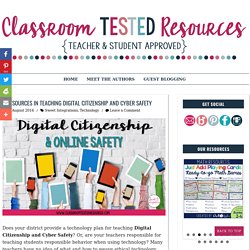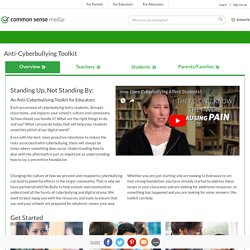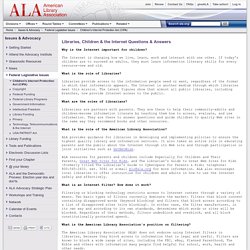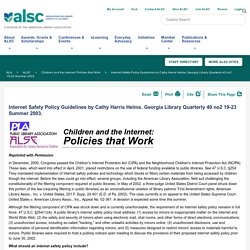

The 5 Best Internet Safety Resources for Teachers - eLearning Industry. What Your Students Really Need to Know About Digital Citizenship. In my classroom, I use two essential approaches in the digital citizenship curriculum that I teach: proactive knowledge and experiential knowledge. Proactive Knowledge I want my students to know the “9 Key Ps” of digital citizenship. While I go into these Ps in detail in my book Reinventing Writing, here are the basics: 1. Passwords: Do students know how to create a secure password? 2. 3. 4. 5. 6. 7. 8. 9. Experiential Knowledge During the year, I touch on each of the points above with lessons and class discussions, but just talking is not enough. Truth or fiction: To protect us from disease, we are inoculated with dead viruses and germs. Turn students into teachers: You can have students create tutorials or presentations exposing common scams and how people can protect themselves.
Collaborative learning communities: For the most powerful learning experiences, students should participate in collaborative learning (like the experiences shared in Flattening Classrooms, Engaging Minds). TEACHING DIGITAL CITIZENSHIP ALL YEAR IN THE CLASSROOM - Erintegration. 4 Resources in Teaching Digital Citizenship and Cyber Safety.
Does your district provide a technology plan for teaching Digital Citizenship and Cyber Safety?

Or, are your teachers responsible for teaching students responsible behavior when using technology? Many teachers have no idea of what and how to weave ethical technology behavior into their curriculum. And, many parents do not monitor their children when they are online at home. Here are some resources that may help.
Our students were born into the digital age. 1. Common Sense Media includes a scope and sequence for different grade levels. 2. That's right! According to the FBI, "The Pew Research Center published a study saying that 92 percent of teens report going online daily - including 24 percent who say they go online "almost constantly. " Anti-Cyberbullying Toolkit. An Anti-Cyberbullying Toolkit for Educators This free toolkit has the resources schools need to take an effective stand against cyberbullying.

Rely on it to start your year off right. Each occurrence of cyberbullying hurts students, disrupts classrooms, and impacts your school's culture and community. So how should you handle it? What are the right things to do and say? Even with the best, most proactive intentions to reduce the risks associated with cyberbullying, there will always be times where something does occur. Download our Cyberbullying Response Flowchart.Better understand how your school can activate student compassion to help stop cyberbullying with No Bully.Make sure your students have access to help when they need it the most with the Crisis Text Line Flyers. In partnership with No Bully We have highlighted our cyberbullying lessons for each grade level, along with giving you everything you need to teach engaging lessons for your classroom around this topic. Grades K-5 Lessons.
Online safety. (eVideo, 2008) A teacher's guide to Internet safety (Book, 2004) How to protect your children on the Internet : a roadmap for parents and teachers (eBook, 2007) Libraries, Children and the Internet. Why is the Internet important for children?

The Internet is changing how we live, learn, work and interact with one other. If today's children are to succeed as adults, they must learn information literacy skills for every resource-new and old. What is the role of libraries? Libraries provide access to the information people need or want, regardless of the format in which that information appears. The Internet is another medium through which libraries meet this mission. What are the roles of librarians? Librarians are partners with parents. What is the role of the American Library Association? Libraries and the Internet Toolkit. ALA strongly encourages every library to adopt, implement and publicize a written Internet use policy in the same way it adopts other library use and access policies.

This policy should be in keeping with your library's mission statement, other access policies and community needs. In light of the Children's Internet Protection Act (CIPA) decision, ALA urges any library using mandatory filtering software to consult with legal counsel to re-evaluate its Internet use policy and assess the risk of future litigation. Traditionally, the children's and young adult sections of the library contain materials selected for these groups, although children are not restricted to those areas. Internet Safety Policy Guidelines by Cathy Harris Helms. Georgia Library Quarterly 40 no2 19-23 Summer 2003. Reprinted with Permission In December, 2000, Congress passed the Children's Internet Protection Act (CIPA) and the Neighborhood Children's Internet Protection Act (NCIPA).

These laws, which went into effect in April, 2001, placed restrictions on the use of federal funding available to public libraries. See 47 U.S.C. §254. They mandated implementation of internet safety policies and technology which blocks or filters certain materials from being accessed by children though the internet. Before the laws could go into effect, several groups, including the American Library Association, field suit challenging the constitutionality of the filtering component required of public libraries. Although the filtering component of CIPA was struck down and is currently unenforceable, the requirement of an internet safety policy remains in full force. 47 U.S.C. §254(1)(A).